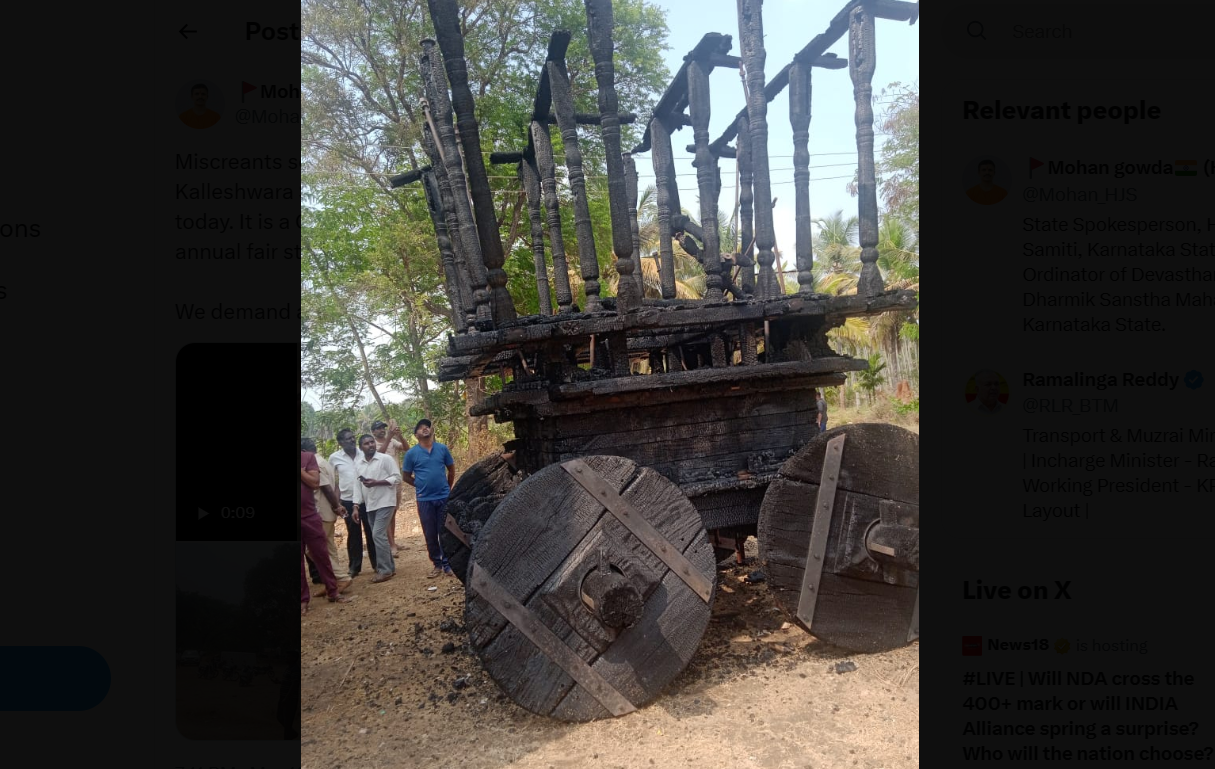The case appears to have taken a different angle with the arrest of a 35-year-old man, a native of Gorakhpur in Uttar Pradesh.

Villagers overlooking the burnt chariot at the Kalleshwara Temple in Tumakuru
The Tumakuru district police in Karnataka have ruled out any communal angle in the incident involving a centuries-old Chola-era chariot being set ablaze by a miscreant on Monday, 11 March.
The case appears to have taken a different angle with the arrest of a 35-year-old man, a native of Gorakhpur in Uttar Pradesh.
The chariot was parked inside an enclosure at the Sri Kalleshwara Swamy Temple situated in the Nittoor village of the Tumakuru district’s Gubbi taluk.
Meanwhile, the villagers are fuming over the incident as the annual fair at the temple is just days away: It is to start on 20 March.
The chariot was allegedly set ablaze by one Sudhari alias Shivadhari, who did odd jobs in the village — sometimes as a painter and at other times as a daily-wage labourer.
According to the police, a few villagers on Monday saw Sudhari running out of the chariot enclosure, from where smoke was emanating.
He apparently told the villagers that he spotted the smoke and went inside to check, but then ran out of the enclosure.
However, other villagers told the local police that Sudhari was found collecting coconut husks and had sneaked inside the chariot enclosure and set it on fire.
Video footage captured on a mobile phone showed the villagers catching hold of Sudhari and beating him up for setting the chariot ablaze before he was handed over to the police.
The iconic wooden chariot, which is said to be 800 years old and belonging to the Chola era, was estimated to be worth around ₹20 lakh by the villagers.
The temple to which the chariot belonged is classified as a C-category temple under the Hindu Religious and Charitable Endowment Department of the state.
Soon after the incident, the videos of the chariot burning inside the enclosure and a man being beaten up for setting the chariot ablaze went viral on social media.
Pro-Hindu organisations took note of the incident and circulated it, allegedly giving the incident a communal tone.
Vishwa Hindu Parishad (VHP) activist and advocate Girish Bharadwaj posted the videos, titling it “The status of Hindu temples under government control”.
He also wrote: “The 800-year-old Sri Kalleshwara Swamy temple in Nittoor, Gubbi taluk, Tumkur district, suffered an arson attack on its Chola-era chariot yesterday.”
𝐓𝐡𝐞 𝐬𝐭𝐚𝐭𝐮𝐬 𝐨𝐟 𝐇𝐢𝐧𝐝𝐮 𝐭𝐞𝐦𝐩𝐥𝐞𝐬 𝐮𝐧𝐝𝐞𝐫 𝐠𝐨𝐯𝐞𝐫𝐧𝐦𝐞𝐧𝐭 𝐜𝐨𝐧𝐭𝐫𝐨𝐥.
The 800-year-old Sri Kalleshwara Swamy temple in Nittoor, Gubbi taluk, Tumkur district, suffered an arson attack on its Chola-era chariot yesterday.
This Temple is “C” grade… pic.twitter.com/QdSqcW6Axy— Girish Bharadwaj (@Girishvhp) March 12, 2024
Hindu Janajagruti Samithi (HJS) Karnataka spokesperson Mohan Gowda posted: “Miscreants set fire to the chariot of the 800-year-old Chola-era Sri Kalleshwara Swamy temple at Nittoor in Gubbi taluk of Tumkur dist. today. It is a C grade temple of the Religious Endowment Dept. & its annual fair starts from March 20th. We demand arrest of culprits @RLR_BTM [sic]”
Miscreants set fire to the chariot of the 800-year-old Chola-era Sri Kalleshwara Swamy temple at Nittoor in Gubbi taluk of Tumkur dist. today. It is a C grade temple of the Religious Endowment Dept. & its annual fair starts from March 20th.
We demand arrest of culprits @RLR_BTM pic.twitter.com/3ECZkQYXbI
— 🚩Mohan gowda🇮🇳 (Hindu Parivar) (@Mohan_HJS) March 11, 2024
Police sources from Gubbi told South First that there was no communal angle to the incident. The Gubbi police have registered an FIR against Sudhari alias Shivadhari, the individual arrested in connection with the case.
A senior police officer told South First that Sudhari was earlier caught a couple of times committing petty offences.
In one instance, he was caught setting fire to the dry leaves he accumulated close to a tree in the village, said the cops.
Sudhari is the son of one Radheshyam, a native of Gorakhpur. However, he told the police during interrogation that he did not belong to Uttar Pradesh but was from Bihar.
His family and friends gave the impression to the police that he could be mentally challenged, and further legal procedures were to be followed in that regard, the aforementioned officer added.
(Edited by Arkadev Ghoshal)

Jul 27, 2024

Jul 26, 2024

Jul 26, 2024

Jul 26, 2024

Jul 26, 2024

Jul 26, 2024